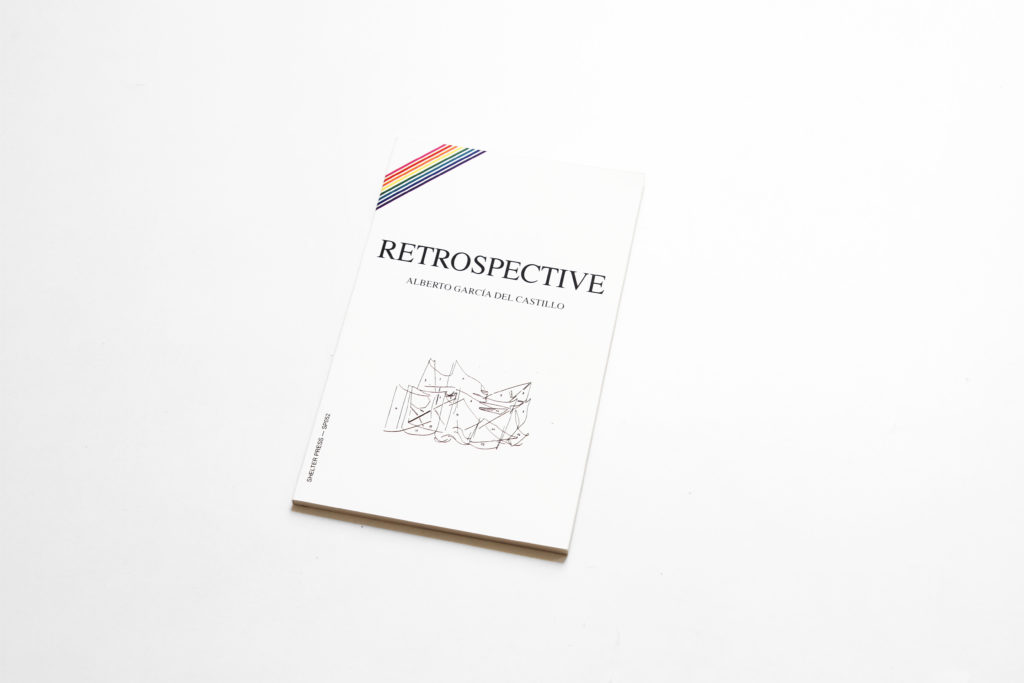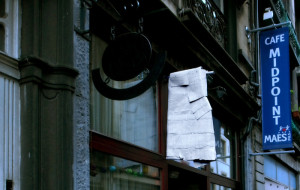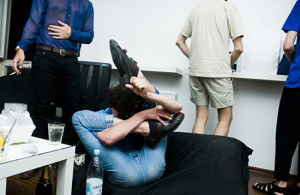Retrospective, published by Shelter Press, is the first novel by self-described “faggot curator and writer” Alberto García del Castillo. The work by the Spanish-born co-founder of Buenos Tiempo Intl. , is deserving of its title; it emerged from a series of del Castillo’s previously published writings from exhibition catalogues, magazines and journals, along with images, words, and phrases borrowed from others. The result is a strange textual hybrid that reads somewhere between science fiction and postmodern theater offering up a broken-mirror reflection of “faggotry and the art world.”
When we enter the world of Retrospective, — what del Castillo has himself qualified as a “fictional exhibition, or a deviant compound of curatorial writing” — it is as though we have entered the Art World, but one in which the curatorial studies students only read absurdist, postmodern novelist Donald Barthelme and nothing else. While the literary side of me laments, the artistic side of me is tickled. The work takes on the worst parts of art land — its fickle trends and its blind consumption of appropriated aesthetics — and hyper-institutionalizes it through the structures of language and government.

The book is playful, with a dry absurdism, and uses the thinly-veiled allegories of science fiction, to call attention to the not-so-distant world in which we live. Structurally, the work is a re-membered rope ladder of quotations, casually appropriated and tied together, a strategy long used in art, but is becoming more of a trend in literature. Of course, the appropriated fragments don’t always make sense in context. The final chapter ‘Handshaking’, acts as a big reveal — functioning both as endnotes, but also as a road map to the actual exhibitions and people that comprise the fictional coagulate you’ve just been through.
The first part of the text takes place in ‘The Land of Sculpture’. It is a land where time is organized according to ‘eras’ designed as such by a bureaucratic architecture of ministries and committees. The current era is ‘The Era of Objects Arrangement’, which (of course) means that ‘The Era of the Denial of the Material’ has come to a close. The re-placing of time into superficial aesthetic categorizations positions the entire narrative in a land where trend has become mandate (wait, that sounds awfully familiar). Accordingly, names are abstracted to shorthand descriptors which are not dissimilar to those given to artists in our contemporary art world context: ‘The Foreign Painter’,’ and ‘The Tyrolese Painter’. When repeated over and over, they become a sort of rhythmic substitute for the individuals they are meant to represent. Not wholly different from the ‘non-fictional’ art ‘world’. As these tongue-in-cheek abstracted names, places, eras pile on one another, it becomes rather difficult to keep up with what is actually going on. This is a Land where superficial qualifications and aesthetic trends are the dominant force in the organization of society; meaning and depth are not part of the conversation.
The ‘faggotry’ of this world did not become wholly transparent to me until later sections of the book. (Perhaps I was meant to read into the prominent description of a sculpture of three giant dicks in the beginning, but as the whole world is full of dicks, I took it at face value). To a certain extent, I think the work is aiming to show how seamlessly the aesthetics and mechanisms of gay culture have been integrated into art and life.

The chapter ‘Why Homos Are Better: (A Masterpiece of Investigative Journalism in Two Parts)’, whose title perhaps suffices in terms of an explanation, makes plain (and quite funny) the case for the pervasive favor of gay culture. The second part of this chapter begins, “It is a little-discussed yet well-known fact amongst educated people that God Himself is a fag.” The hyperbolic nature of such assertions mimics compensatory rhetoric of the gay pride mentality. Yet in its tongue-in-cheek tone, it simultaneously questions whether such a mentality actually contributed to the demise and integration of gay culture into the mainstream.
‘Thumbs-Up’ goes into a more nuanced examination of the “normalisation of gayness.” A page-long list of all the “lost gay bars and baths in San Francisco” compiled by American filmmaker and journalist Mike Stabile on Google Maps resonated with me deeply. The list reads as a memorial to a bygone era of pre-AIDS San Francisco, which now only exists in the minds of those who lived it, and in the fantasies of those who wish they had. That the list itself is housed in Google Maps adds another level of irony: it is now well-known that San Francisco has been colonized by ‘Googlers’, whose presence has radically inflated the real-estate market and pushed the ‘weird’ San Francisco to the periphery. Of course, part of the critique issued by this wonky, channel-surfing pseudo-fiction is that the aesthetics of gayness, rather than the history and politics, have been seamlessly co-opted by the [art] world, normalized, commodified, disseminated.
While the majority of the work in Retrospective is functionally getting off on itself (for the more noble end of societal/institutional critique), there still exist some moments of poetry that allow for some soul, and some hope (for humanity) in this otherwise bleak, confined, superficial landscape. The book opens with a mini-chapter, ‘WAVING’, in which the sole thing written is, “I see all the beautiful faces.” Similarly, ‘ENTR’ACTE’, breaks the cadence of the hermetic world of ‘The Land of Sculptures’. The speaker writes, “My father dancing an improvised waltz to the audio guide music in the Hall of Mirrors at the Palace of Versailles in the outskirts of Paris.” This quiet image, whether true or invented, conjures a patriarch whose body and masculinity is swept away into what is maybe The monument to monarchic opulence — vulnerable to the beauty that surrounds him.**
















